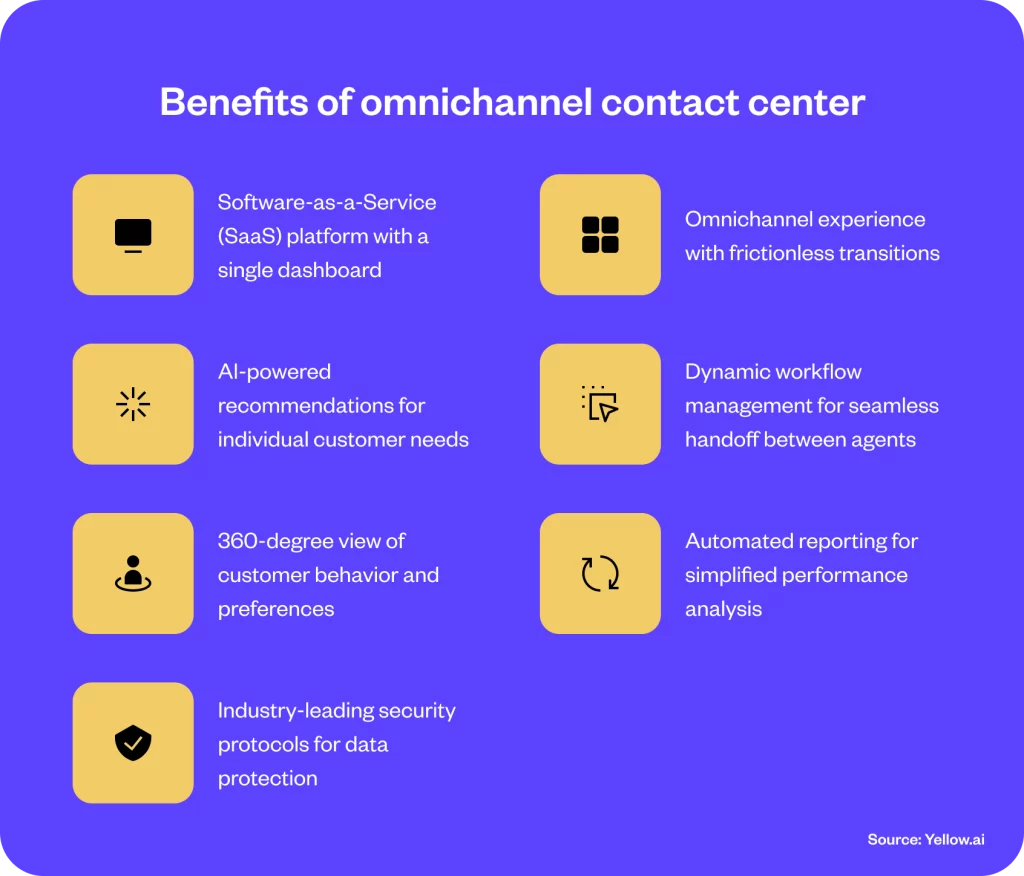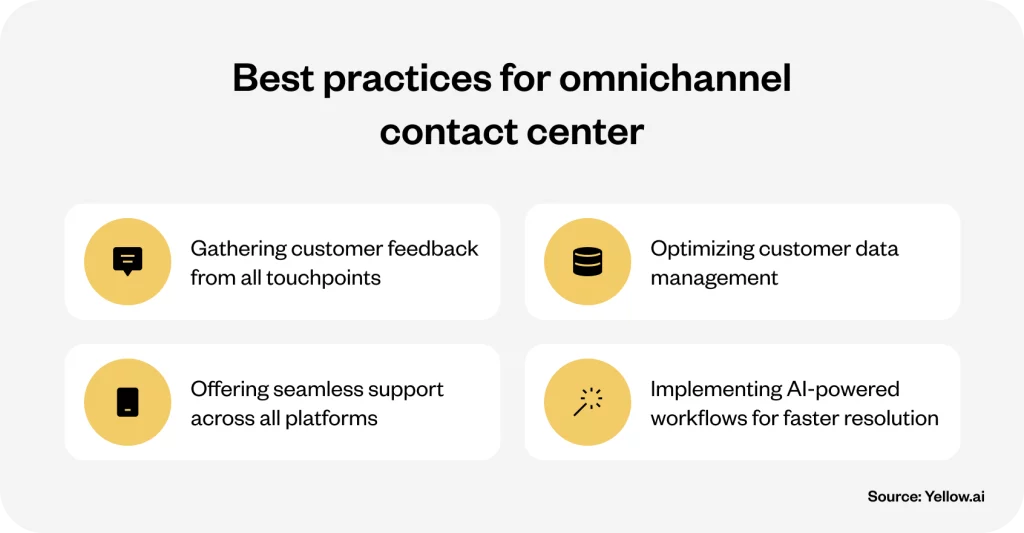Executive summary
Omnichannel contact center emerges as a critical nexus in customer service strategies in today’s interconnected world. This blog offers detailed insights on omnichannel contact centers, highlighting their unique ability to blend various communication channels into a cohesive customer experience. We also decode the essential differences between omnichannel and multichannel approaches and explain the benefits of omnichannel contact centers. This guide is an indispensable resource for managers aiming to adapt and thrive in the ever-evolving landscape of customer interaction.
Introduction
Omnichannel contact centers are a game-changer for business managers in this arena of modern customer service. Gone are the days when customer interactions were confined to siloed channels. Omnichannel centers have replaced those traditional channels and weave a tapestry of communication options – from traditional phone calls to the latest in social media engagement. This shift is a response to a customer base that craves seamless, integrated experiences across all platforms.
The following sections explain the core of what makes these omnichannel contact centers tick, their impact on customer satisfaction, and the strategic edge they offer businesses. As the digital landscape evolves, customers aren’t just hoping for multiple ways to connect; they demand a fluid, cohesive experience. This blog aims to explain the concept of the omnichannel contact center, illustrating its importance in the contemporary market. We will also provide actionable insights for managers ready to harness its power for superior customer engagement and business growth.
Related must-reads:
- Contact center automation: Revolutionize your customer service
- Cloud contact centers: Transforming customer service
- Call center software – A Complete Guide [2024]
- A guide on omnichannel customer engagement
What is an omnichannel contact center?
Customer expectations are sky-high today, and the omnichannel contact center is the solution for modern customer service excellence. An omnichannel contact center is a sophisticated platform that integrates diverse communication channels, including phone calls, emails, live chat, social media, and text messaging, into a cohesive and interconnected framework. This integration transforms customer interactions from being compartmentalized into a unified, continuous conversation stream.
The core of an omnichannel contact center is its comprehensive approach to managing customer communications. Picture this: a customer begins their query via a social media message, then transitions to email, and eventually opts for a phone call for immediate resolution. In conventional setups, each of these steps would be discrete and disconnected. However, an omnichannel platform facilitates a smooth transition across these mediums. The customer service representative has access to the entire interaction history across channels, allowing for a more informed, efficient, and personalized response.
More than just facilitating convenience, the omnichannel approach offers a strategic edge. Statistics from Aberdeen Group highlight a whopping 91% increase in year-over-year customer retention rates for companies adopting an omnichannel strategy. This data highlights the importance of meeting customers on their preferred platforms and also ensuring a consistently high-quality service experience across these channels.
This approach is fundamentally different from multichannel contact centers, where the channels, though multiple, often operate independently without interconnection. Omnichannel contact centers are about creating a seamless narrative in customer service, ensuring that no matter how or where a customer reaches out, the experience remains consistent, contextual, and highly satisfactory.
What is the difference between Multichannel and Omnichannel contact centers?
As the digital landscape reshapes customer service expectations, understanding the nuances between multichannel and omnichannel contact centers becomes essential. Let us elucidate their differences and implications for businesses striving for customer service excellence.
Related read: Omnichannel vs multichannel customer service – What is the difference?
Multichannel contact centers
A multichannel contact center is like a Swiss Army knife – versatile but compartmentalized. It offers multiple channels of communication, such as email, phone, webchat, and social media, but these channels tend to operate in silos. Each channel is managed separately, and there’s limited integration between them. It means that while a customer may reach out through various channels, the continuity of their experience can get lost in transition. Agents in a multichannel setup often excel in one channel but may not be equipped to switch seamlessly to another, leading to a disjointed customer experience.
Omnichannel contact centers
In contrast, an omnichannel contact center is just like a well-orchestrated symphony. Besides supporting multiple communication channels, it integrates them into a harmonious, unified platform. In this environment, a conversation can fluidly move from social media to email to phone, with all interaction history accessible in real time. It means that customers don’t need to repeat their stories with every switch, and agents can provide a more informed, personalized service. Omnichannel contact centers are staffed by agents who are adept across multiple channels and have access to a comprehensive customer data platform (CDP), enabling them to offer superior service across the board.
The distinction between these models can be best summarized in the given table:
| Feature | Multichannel Contact Center | Omnichannel Contact Center |
| Supports Multiple Channels | Yes | Yes |
| Integrated Communication Channels | No | Yes |
| Continuous Customer Experience Across Channels | No | Yes |
| Unified Customer Interaction History | No | Yes |
| Seamless Agent Switching Across Channels | No | Yes |
The critical difference lies in the level of integration and continuity. While multichannel centers provide various communication paths, they often fall short of creating a cohesive customer journey. Customers may find themselves repeating information as they hop from one channel to another. On the other hand, omnichannel centers ensure that each channel is part of a singular, continuous customer narrative, enhancing the overall experience and reducing frustration.
This distinction significantly impacts customer satisfaction and business efficiency. Multichannel models, though seemingly diverse, can lead to fragmented experiences and higher operational costs due to the need for multiple specialized teams. In contrast, omnichannel centers offer a more cost-effective and customer-centric approach, leading to higher customer retention and loyalty.
So, while both models aim to diversify customer communication channels, the omnichannel approach stands out for its integrated, customer-first strategy, marking a significant evolution in contact center solutions.
Unify your CX with omnichannel AI automation
What are the benefits of omnichannel contact center?
Customer service has transcended traditional boundaries, and omnichannel contact centers are at the forefront of this evolution. Let us shed light on why omnichannel contact centers are a crucial ingredient for customer service success.

1. Software-as-a-Service (SaaS) platform with a single dashboard
Omnichannel contact centers, being cloud-based SaaS platforms, offer a singular, streamlined dashboard that consolidates customer interactions from various channels. This centralized interface allows agents to effortlessly navigate through different communication modes while maintaining an ongoing context of the customer journey.
Imagine having a control panel that brings together every customer interaction, regardless of the channel. That’s what an omnichannel contact center offers. Here, every tool, from email to social media, is integrated into one streamlined dashboard. This unified approach simplifies the agent’s task, ensuring they have the entire customer journey at their fingertips, leading to more informed interactions and a significant boost in efficiency.
Example
Imagine a busy day at the customer service department of an online retail store. A customer calls inquiring about the status of their order, followed by a query on product return policies. Thanks to the omnichannel SaaS platform, the agent swiftly pulls up the customer’s purchase history, current order status, and return policy information—all from a single dashboard. This seamless access enables the agent to provide quick and comprehensive responses, turning what could have been a complex inquiry into a smooth and satisfactory interaction.
2. Omnichannel experience with frictionless transitions
The true essence of an omnichannel experience lies in its ability to provide smooth transitions between different communication channels without any friction. Customers can shift from chatting on social media to a phone call without missing a beat.
The omnichannel universe is where a conversation can gracefully hop from Instagram DMs to email, then to a phone call, without any hitches. It’s like a customer walking through different rooms in your digital house, yet feeling the same warmth and welcome in each. This seamless continuity elevates the customer experience and also fosters a sense of trust and reliability in your brand.
Example
Sarah started browsing for a new pair of running shoes on her favorite sports store’s mobile app but wanted to ask a few questions before making a purchase. She used the live chat feature in the app to inquire, and later, while on her lunch break, decided to call customer service for further clarification. The service agent on the call already had all the chat details and Sarah’s preferences at hand, thanks to the omnichannel platform. This seamless transition from app chat to phone call made Sarah feel genuinely heard and cared for, enhancing her shopping experience.
3. AI-powered recommendations for individual customer needs
Integrating artificial intelligence (AI) into omnichannel platforms enhances customer interactions. AI algorithms analyze customer data and interaction history to provide personalized recommendations and responses. This technology enables businesses to cater to individual customer needs with unprecedented precision, ensuring that every interaction is as relevant and helpful as possible.
Example
A customer reaching out via chat. The AI system recognizes their preference for quick shipping options, prompting the agent to offer expedited delivery before the customer asks. This preemptive service feels like a personal concierge anticipating needs before they’re expressed.
4. Dynamic workflow management for seamless handoff between agents
Efficient workflow management is vital in a dynamic customer service environment. Omnichannel contact centers facilitate a seamless handoff of customer interactions between agents and departments. This dynamic flow ensures that customers receive consistent and informed service, regardless of the complexity of their queries or the number of agents involved in resolving their issues.
Example
A customer calls about a technical issue and needs billing support midway. The agent transfers the call with all the background info intact. The billing department picks up exactly where the tech support left off, like a seamless scene change in a well-scripted play.
5. 360-degree view of customer behavior and preferences
Omnichannel contact centers provide a comprehensive 360-degree view of customer behavior and preferences. By aggregating data from all touchpoints, businesses gain deep insights into customer patterns, enabling them to tailor their services and communication strategies effectively. This holistic understanding is vital to delivering a customer experience that resonates on a personal level.
Example
Using data from previous purchases, a customer service agent suggests accessories that perfectly match the customer’s recent laptop purchase. This insight-driven recommendation is like a skilled chef who knows just the right ingredients to add to your favorite dish.
6. Automated reporting for simplified performance analysis
Automated reporting tools embedded in omnichannel platforms simplify the task of performance analysis. These tools provide real-time insights into various metrics, such as response times, customer satisfaction levels, and agent efficiency. Managers can leverage this data to make informed decisions, streamline operations, and continuously improve service quality.
Example
A manager reviews weekly performance reports and quickly identifies a trend in rising call times. They promptly arrange training to address this, similar to a coach analyzing game tapes to improve team performance.
7. Industry-leading security protocols for data protection
In the era of heightened cybersecurity risks, omnichannel contact centers prioritize data protection with industry-leading security protocols. This commitment to safeguarding customer information complies with regulatory standards and also reinforces customer trust in the brand’s commitment to privacy and security.
Example
John, a frequent shopper at a popular e-commerce platform, received an email alert about an attempted login to his account from an unrecognized device. The platform’s robust security protocols detected unusual activity and immediately required additional verification before granting access. John was reassured that his personal and payment information was protected by cutting-edge security measures, reinforcing his trust in the e-commerce brand’s commitment to safeguarding customer data.
Related read: Ecommerce Chatbot for Your Business [+Examples]
Best practices for omnichannel contact center
Implementing the following practices can help businesses streamline their omnichannel contact centers and also significantly enhance the customer experience. It’s about creating a service ecosystem that is efficient, responsive, and, above all, customer-centric. These practices are more than just theoretical concepts. Instead, they are proven strategies that have enhanced customer satisfaction and operational efficiency for numerous businesses.

1. Gathering customer feedback from all touchpoints
Continuously collecting feedback across all channels provides a comprehensive understanding of customer experiences. This practice involves actively seeking customer opinions post-interaction, be it through surveys, feedback forms, or direct conversations. This approach leads to valuable insights into service gaps and areas needing improvement. It enhances customer engagement and helps tailor services to meet customer expectations more accurately.
2. Optimizing customer data management
Effective data management involves organizing and analyzing customer data from all channels to create a unified customer view. It includes integrating CRM systems with omnichannel platforms. With organized data, businesses can provide more personalized and efficient service. It leads to quicker issue resolution and a more seamless customer experience.
3. Offering seamless support across all platforms
This practice ensures that customers receive consistent and high-quality service, regardless of the channel they choose. It involves training agents to deliver uniform service across platforms and ensuring technological consistency. It builds customer trust and loyalty as they receive dependable support on their preferred channels. It also minimizes confusion and enhances brand credibility.
4. Implementing AI-powered workflows for faster resolution
Incorporating AI-driven workflows automates routine tasks and offers predictive solutions based on customer behavior and history. It includes using chatbots for initial interactions and routing complex queries to human agents. AI-powered workflows expedite problem-solving and free up human agents for more complicated issues, improving overall operational efficiency.
How Yellow.ai can enhance customer service by deploying omnichannel contact support
Seamless and integrated communication is vital in today’s customer service arena. Yellow.ai stands at the forefront of this technological innovation and offers efficient solutions. Our AI-powered chatbots are catalysts that transform omnichannel contact centers into dynamic customer interaction hubs. Here is how Yellow.ai revolutionizes customer support with its cutting-edge technology and omnichannel support.
Yellow.ai: Revolutionizing omnichannel support
- Unified interface: Yellow.ai’s chatbots excel in integrating various communication channels into one coherent system. This harmonization ensures that no customer query is left unanswered, regardless of the platform.
- Real-time data access: With a deep understanding of the importance of timely responses, our chatbots provide immediate access to relevant customer data. It helps streamline interactions and enhance customer satisfaction.
- Intuitive AI technology: The AI-driven recommendations are tailored to individual customer preferences. They can predict needs and offer solutions even before they are articulated.
- Seamless transition across channels: Yellow.ai chatbots master the art of moving conversations smoothly across different platforms, from social media to emails, without losing the context.
- Robust security protocols: We recognize the critical importance of data security. Hence, our AI chatbots follow industry-leading robust compliance standards like HIPAA, ISO 27001, ISO 27018, and SOC 2 Type II to ensure customer data is always protected.
The concluding thoughts
Omnichannel contact centers are a necessity in the modern customer service landscape. They represent the evolving nature of customer interaction, where flexibility, integration, and personalization are not just valued but expected. Implementing an omnichannel approach is a critical strategy for businesses aiming to stay relevant and excel in customer satisfaction.
Omnichannel contact centers are the future, and the future is here. It’s time to embrace this change and empower your business with a strategy that aligns with the contemporary customer’s needs.
Frequently asked questions (FAQs)
How to measure costs in an omnichannel contact center?
Measuring costs involves analyzing operational expenses against customer engagement metrics. It includes assessing the efficiency of communication channels, labor costs, and technology investments and correlating them with customer satisfaction and loyalty metrics.
Why is an Omnichannel Contact Center important for customer experience?
Omnichannel Contact Centers are pivotal for enhancing customer experience as they provide a seamless and integrated communication journey across various channels. This consistency in service delivery leads to increased customer satisfaction and loyalty.
What challenges do businesses face when implementing an omnichannel contact center?
Businesses often encounter challenges like integrating various communication platforms, training staff across multiple channels, maintaining consistent service quality, and managing data security and privacy.
How does an omnichannel approach impact customer satisfaction?
An omnichannel approach positively impacts customer satisfaction by offering a cohesive and personalized service experience. It eliminates the frustration of repeating information across channels and provides timely and relevant solutions, enhancing overall customer engagement.
What technologies are typically used in an omnichannel contact center?
Essential technologies include cloud-based solutions for seamless integration, AI for personalized interactions, advanced CRM systems for data management, and robust networking infrastructure for secure communications.
How can businesses measure the success of their omnichannel strategy?
Success can be gauged through customer retention rates, response and resolution times, customer feedback and satisfaction levels, and overall improvements in sales and revenue influenced by enhanced customer service.
What future trends are emerging in omnichannel contact centers?
Emerging trends include the integration of AI and machine learning for more predictive customer service, the use of virtual and augmented reality for immersive experiences, and a stronger focus on mobile and social media platforms to cater to evolving customer preferences.




















